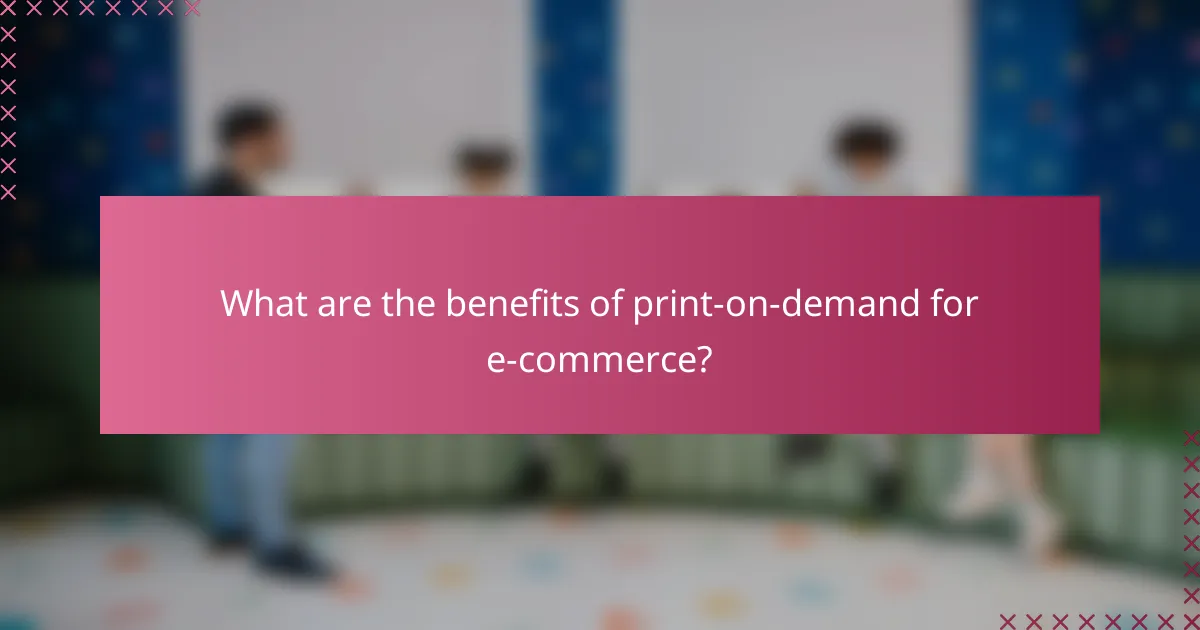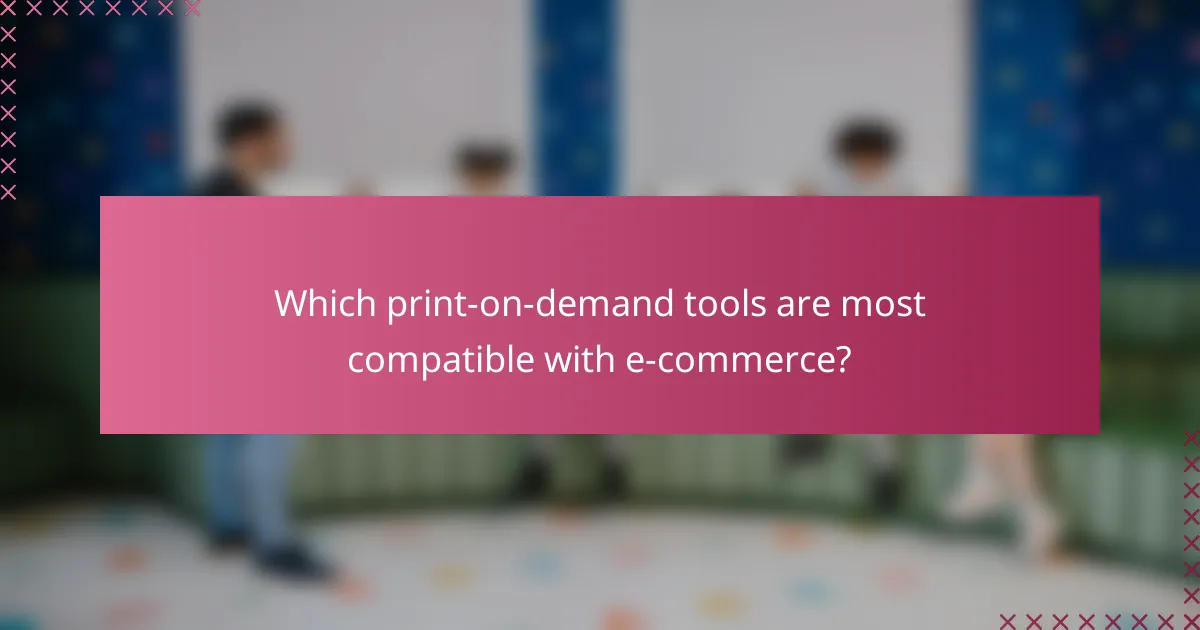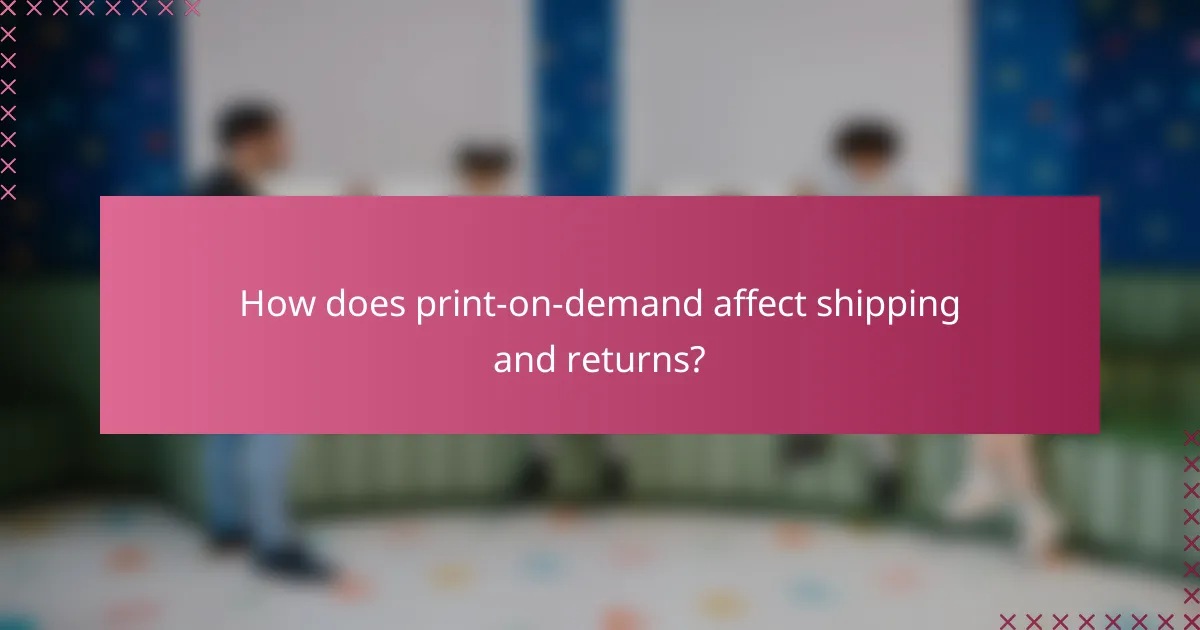Integrating print-on-demand (POD) with e-commerce platforms enables businesses to automate order fulfillment and manage inventory efficiently. This connection allows sellers to produce items only as they are ordered, reducing upfront costs and minimizing risks associated with unsold inventory. With various tools like Printful, Printify, and Gooten available, businesses can enhance their online selling experience while enjoying the flexibility that POD offers.

How to integrate print-on-demand with e-commerce platforms?
Integrating print-on-demand with e-commerce platforms allows businesses to streamline their operations by automating order fulfillment and inventory management. This process typically involves connecting your online store to a print-on-demand service through an app or plugin, enabling seamless order processing and product creation.
Shopify integration
Shopify offers various print-on-demand apps, such as Printful and Teespring, which can be easily installed from the Shopify App Store. After installation, you can customize products and set pricing directly within your Shopify dashboard.
Ensure you configure shipping settings and tax calculations to align with your business model. Regularly check for updates from your chosen app to maintain compatibility and access new features.
WooCommerce integration
WooCommerce integrates with print-on-demand services like Printify and Gooten through plugins that can be added to your WordPress site. Once installed, you can create products and manage orders directly from your WooCommerce interface.
Pay attention to your hosting capabilities, as high traffic can affect performance. It’s advisable to test the integration with a few orders before fully launching your print-on-demand offerings.
Etsy integration
Etsy allows integration with print-on-demand services such as Printful, enabling sellers to offer custom products without holding inventory. You can connect your Etsy shop to the print-on-demand service by following the setup instructions provided by the service.
Be mindful of Etsy’s policies regarding shipping times and product quality, as these can impact your shop’s reputation. Regularly review customer feedback to ensure your print-on-demand products meet expectations.
BigCommerce integration
BigCommerce supports print-on-demand through apps like Printful and Apliiq, which can be integrated via the BigCommerce App Marketplace. After connecting, you can manage product listings and orders from your BigCommerce dashboard.
Consider your target market when selecting print-on-demand products, as customization options can vary. Ensure that your pricing strategy accounts for production and shipping costs to maintain profitability.
Magento integration
Magento can integrate with print-on-demand services such as Printful through extensions available in the Magento Marketplace. After installation, you can set up product templates and automate order fulfillment directly from your Magento store.
Keep in mind that Magento requires more technical expertise compared to other platforms, so ensure you have the necessary resources for setup and maintenance. Regularly update your extensions to enhance functionality and security.

What are the benefits of print-on-demand for e-commerce?
Print-on-demand (POD) offers several advantages for e-commerce businesses, including cost savings, flexibility, and reduced risk. By allowing sellers to produce items only as they are ordered, POD minimizes upfront investments and inventory management challenges.
Reduced inventory costs
One of the primary benefits of print-on-demand is the significant reduction in inventory costs. Traditional retail models require businesses to purchase large quantities of products upfront, which ties up capital. With POD, you only pay for items after they are sold, allowing for better cash flow management.
This model eliminates the need for storage space and reduces overhead costs associated with unsold inventory. As a result, even small businesses can operate without the financial burden of maintaining stock.
Customizable product offerings
Print-on-demand allows e-commerce businesses to offer a wide range of customizable products without the risk of overproduction. Sellers can create unique designs for various items such as t-shirts, mugs, and posters, catering to niche markets and individual customer preferences.
This flexibility enables businesses to test new designs and trends quickly, adapting their offerings based on customer feedback and market demand. As a result, sellers can maintain a fresh and appealing product line with minimal investment.
Scalability for small businesses
POD is particularly beneficial for small businesses looking to scale without significant upfront investment. As orders increase, the POD model allows for easy expansion since production is handled by third-party suppliers. This means you can focus on marketing and customer engagement rather than production logistics.
Moreover, many POD platforms integrate seamlessly with e-commerce sites, automating order processing and fulfillment. This integration streamlines operations, enabling small businesses to grow efficiently and effectively.
Lower risk of unsold stock
With print-on-demand, the risk of unsold stock is drastically reduced. Since products are only created after a customer places an order, businesses do not have to worry about leftover inventory that may not sell. This aspect is crucial for seasonal items or trends that can quickly change.
By minimizing the risk of unsold products, e-commerce sellers can allocate resources more effectively and focus on marketing strategies that drive sales. This approach not only protects profits but also enhances overall business sustainability.

Which print-on-demand tools are most compatible with e-commerce?
Several print-on-demand tools integrate seamlessly with e-commerce platforms, enhancing the online selling experience. Key options include Printful, Printify, Gooten, and Teespring, each offering unique features and compatibility with various e-commerce systems.
Printful
Printful is a popular print-on-demand service known for its extensive product range and high-quality printing. It integrates smoothly with major e-commerce platforms like Shopify, WooCommerce, and Etsy, allowing sellers to automate order fulfillment easily.
One of Printful’s standout features is its mockup generator, which helps users create product images for their online stores. Additionally, it offers warehousing and fulfillment services, enabling sellers to store their products and ship them directly to customers.
Printify
Printify is another leading print-on-demand tool that provides a wide selection of products and printing partners. It supports integration with platforms such as Shopify, Etsy, and Wix, making it accessible for various online businesses.
With Printify, users can choose from multiple print providers, allowing them to compare prices and shipping options. This flexibility can help businesses optimize costs and delivery times, making it a practical choice for e-commerce entrepreneurs.
Gooten
Gooten offers a robust print-on-demand solution with a focus on customization and scalability. It integrates with e-commerce platforms like Shopify and WooCommerce, providing a user-friendly interface for managing orders and products.
One of Gooten’s advantages is its ability to handle large volumes of orders, making it suitable for growing businesses. It also offers a variety of products, from apparel to home goods, catering to diverse market needs.
Teespring
Teespring, now known as Spring, specializes in custom apparel and merchandise, making it a great choice for creators and influencers. It integrates with platforms like Shopify and offers a unique marketplace for sellers to reach a broader audience.
Teespring’s user-friendly design tools allow sellers to create and launch products quickly. It also provides features like fundraising campaigns, enabling users to support causes while selling their merchandise.

What are the key criteria for selecting a print-on-demand provider?
When selecting a print-on-demand provider, consider factors such as product quality, shipping options, integration ease, and customer support. These criteria will help ensure that your e-commerce operations run smoothly and meet customer expectations.
Product quality
Product quality is crucial for maintaining customer satisfaction and brand reputation. Look for providers that offer high-resolution printing, durable materials, and a variety of customizable options. Request samples to evaluate the print quality and material feel before making a decision.
Additionally, check for reviews or testimonials from other businesses to gauge the consistency of product quality. A provider that frequently delivers high-quality products will help reduce returns and increase customer loyalty.
Shipping options
Shipping options can significantly impact customer experience and order fulfillment speed. Choose a provider that offers multiple shipping methods, including standard, expedited, and international options. This flexibility allows customers to select a shipping method that meets their needs and budget.
Consider the average shipping times and costs associated with each option. Providers that have partnerships with reliable carriers can often provide better rates and faster delivery, enhancing your overall service offering.
Integration ease
Integration ease refers to how well the print-on-demand service connects with your existing e-commerce platform. Look for providers that offer seamless integration with popular platforms like Shopify, WooCommerce, or Etsy. This will streamline your order processing and inventory management.
Evaluate the technical support and documentation provided by the provider to assist with the integration process. A user-friendly setup can save you time and reduce potential issues as you scale your business.
Customer support
Reliable customer support is essential for addressing issues quickly and maintaining smooth operations. Choose a print-on-demand provider that offers multiple support channels, such as live chat, email, and phone support. This ensures you can get assistance when you need it most.
Check the availability of support hours and response times. A provider that offers 24/7 support can be particularly beneficial for businesses operating across different time zones or during peak sales periods.

How does print-on-demand affect shipping and returns?
Print-on-demand (POD) significantly influences shipping and returns by streamlining the fulfillment process and altering customer expectations. With POD, products are created only after an order is placed, which can lead to longer shipping times but often results in lower upfront costs for retailers.
Shipping Considerations
When using print-on-demand services, shipping times can vary widely depending on the provider and the customer’s location. Typically, customers may expect delivery within a week to two weeks, as items are printed and shipped after the order is confirmed. It’s essential to communicate these timelines clearly to avoid dissatisfaction.
Additionally, consider the shipping costs associated with POD. Many providers offer flat-rate shipping, while others may charge based on distance or weight. Evaluate these options to determine which aligns best with your pricing strategy and customer expectations.
Returns Management
Returns in a print-on-demand model can be more complex than traditional retail. Since items are custom-made, many POD providers have strict return policies, often only accepting returns for defective products. Make sure to understand and communicate these policies to your customers to manage expectations effectively.
To streamline returns, consider implementing a clear return process that includes easy-to-follow instructions and return labels. This can enhance customer satisfaction and encourage repeat business, even if the initial purchase did not meet their expectations.
Customer Communication
Effective communication regarding shipping and returns is crucial in a print-on-demand business. Clearly outline shipping times, costs, and return policies on your website to set proper expectations. Use automated emails to keep customers informed about their order status, which can help reduce inquiries and enhance their experience.
Additionally, consider using customer feedback to refine your shipping and return processes. Regularly review feedback to identify common issues and adjust your policies or practices accordingly, ensuring a smoother experience for future customers.
